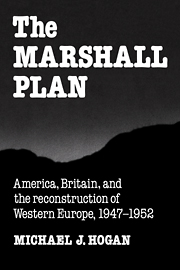Book contents
- Frontmatter
- Contents
- Editors' preface
- Preface
- Introduction: Toward the Marshall Plan: from New Era designs to New Deal synthesis
- 1 Searching for a “creative peace”: European integration and the origins of the Marshall Plan
- 2 Paths to plenty: European recovery planning and the American policy compromise
- 3 European union or middle kingdom: Anglo–American formulations, the German problem, and the organizational dimension of the ERP
- 4 Strategies of transnationalism: the ECA and the politics of peace and productivity
- 5 Changing course: European integration and the traders triumphant
- 6 Two worlds or three: the sterling crisis, the dollar gap, and the integration of Western Europe
- 7 Between union and unity: European integration and the sterling–dollar dualism
- 8 Holding the line: the ECA's efforts to reconcile recovery and rearmament
- 9 Guns and butter: politics and diplomacy at the end of the Marshall Plan
- Conclusion: America made the European way
- Bibliography
- Index
2 - Paths to plenty: European recovery planning and the American policy compromise
Published online by Cambridge University Press: 31 October 2009
- Frontmatter
- Contents
- Editors' preface
- Preface
- Introduction: Toward the Marshall Plan: from New Era designs to New Deal synthesis
- 1 Searching for a “creative peace”: European integration and the origins of the Marshall Plan
- 2 Paths to plenty: European recovery planning and the American policy compromise
- 3 European union or middle kingdom: Anglo–American formulations, the German problem, and the organizational dimension of the ERP
- 4 Strategies of transnationalism: the ECA and the politics of peace and productivity
- 5 Changing course: European integration and the traders triumphant
- 6 Two worlds or three: the sterling crisis, the dollar gap, and the integration of Western Europe
- 7 Between union and unity: European integration and the sterling–dollar dualism
- 8 Holding the line: the ECA's efforts to reconcile recovery and rearmament
- 9 Guns and butter: politics and diplomacy at the end of the Marshall Plan
- Conclusion: America made the European way
- Bibliography
- Index
Summary
At the time of the three-power conference in Paris, the State Department had not devised a concrete plan for stabilizing Europe. Instead of a plan, there had emerged an emphasis on European initiative in drafting a recovery program, a determination to provide the Europeans with limited “friendly aid” in the drafting process, and a set of principles to guide European and American action. In addition to maximum self-help, mutual aid, and resource sharing, American leaders were talking about the importance of liberalizing intra-European trade, making currencies convertible, and using central institutions to coordinate national policies. A comprehensive recovery plan founded on such concepts, or so the Americans assumed, would erase the traditional territorial constraints on European enterprise, abolish old habits of bilateralism and restrictionism, and eliminate archaic concerns with national self-sufficiency and autonomy. These attributes were seen as barriers to maximum productivity, and they were to give way now to a large, functionally ordered, and organically integrated economy similar to the one that existed in the United States. This was the American way to stable abundance and social peace in Western Europe and to a fully multilateral system of world trade.
Together with supranational institutions of coordination and control, economic integration would also help to build a viable balance of power among the states of Western Europe and a workable correlation of forces on the Continent. It would create a unit coherent enough to harness Germany's industrial strength without restoring its prewar dominance and strong enough to countervail the Soviet bloc in Eastern Europe.
- Type
- Chapter
- Information
- The Marshall PlanAmerica, Britain and the Reconstruction of Western Europe, 1947–1952, pp. 54 - 87Publisher: Cambridge University PressPrint publication year: 1987

